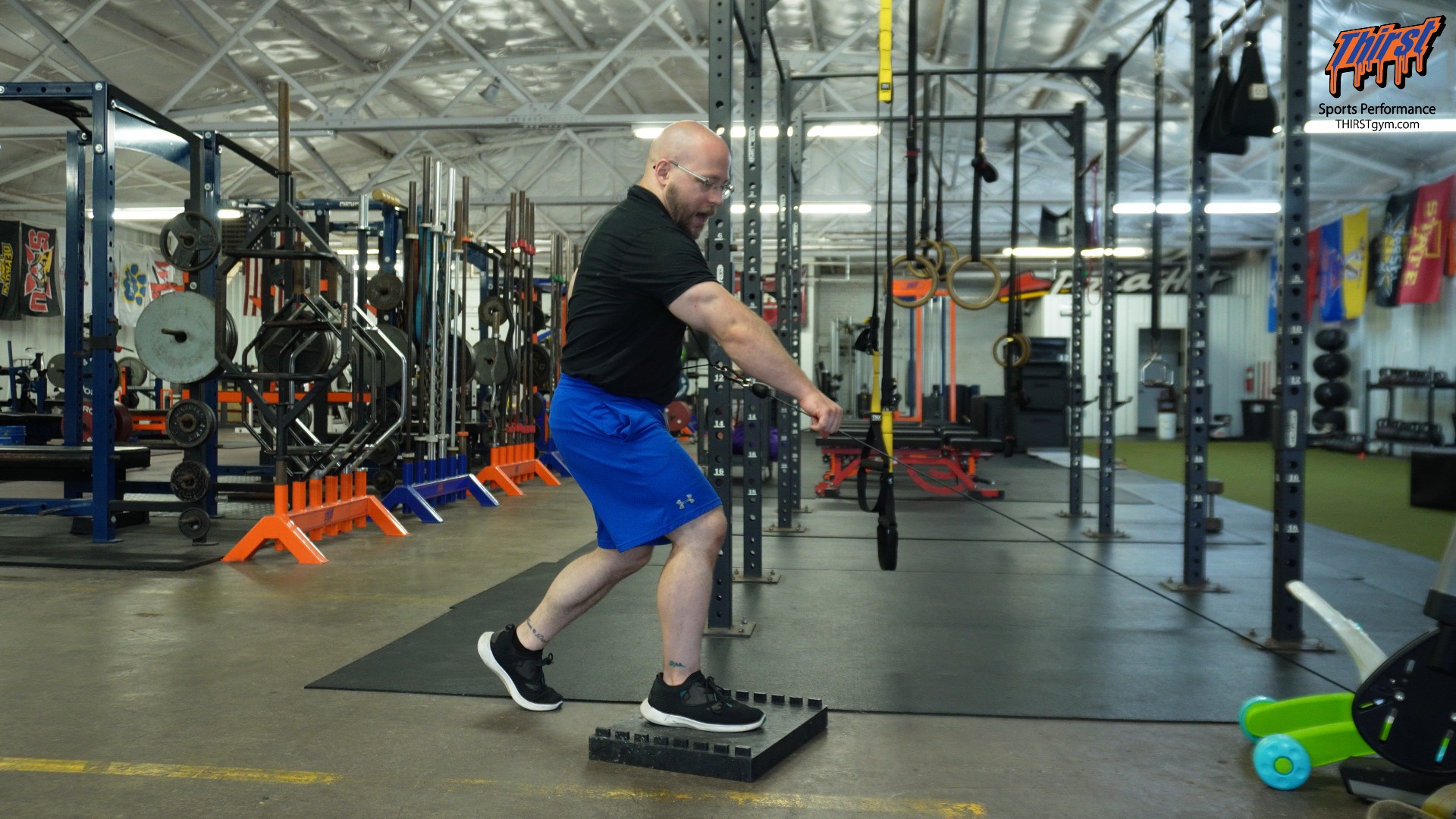Front Foot Elevated Split Stance Low Cable Row with Opposite Reach: The Ultimate Athletic Upper Back Exercise
When it comes to building functional upper back strength while improving mobility and posture, few exercises deliver the comprehensive benefits of the front foot elevated split stance low cable row with opposite reach. This dynamic movement combines the pulling strength of a traditional cable row with the stability challenges of a split stance position, creating an exercise that’s perfect for athletes and fitness enthusiasts looking to develop real-world strength.
Watch the video below on how to maximize this exercise.
Why This Cable Row Variation Stands Out
Traditional cable rows are excellent for building upper back strength, but they often lack the functional movement patterns we use in daily life and sports. This elevated split stance variation transforms a basic pulling exercise into a full-body movement that challenges your balance, improves hip mobility, and enhances thoracic spine rotation—all while building serious upper back strength.
The beauty of this exercise lies in its ability to address multiple movement quality issues simultaneously. By elevating the front foot and incorporating the opposite reach component, you’re creating a movement that naturally promotes better posture while challenging your body in multiple planes of motion.
Equipment and Setup Requirements
Before diving into this exercise, you’ll need some basic gym equipment that’s available in most fitness facilities:
Essential Equipment:
- Cable machine with adjustable height settings
- D-handle or standard cable attachment
- Elevation platform (2-3 inches high): exercise block, weight plates, or gym mats
- Adequate space to move into a split stance position
The key to success with this movement starts with proper equipment setup. Position your cable machine at the lowest possible setting—this low cable angle is crucial for the exercise’s effectiveness. The elevation platform should provide just 2-3 inches of height; any higher and you’ll compromise the movement’s stability and effectiveness.
Step-by-Step Exercise Execution
Understanding proper form is essential for maximizing the benefits of this complex movement. Let’s break down the execution into manageable steps:
Initial Setup: Start by grasping the cable handle and walking backward to create tension in the cable. The key positioning rule is simple: whichever hand holds the cable, the opposite foot goes on the elevation platform. This cross-body setup creates the foundation for the movement’s rotational benefits.
Split Stance Position: Move into a lunge-like split stance with your elevated foot forward and your back leg extended behind you. Lower yourself slightly into this position, but don’t drop into a full lunge. The goal is to find a stable, athletic stance that allows for controlled movement.
The Rowing Motion: With your pulling arm extended as long as possible, initiate the row by driving your elbow back while simultaneously reaching your opposite arm across your body toward where the cable originates. This cross-body reach is what creates the exercise’s unique rotational component.
Return and Reset: Control the movement back to the starting position, maintaining tension in the cable throughout the entire range of motion. The front elevated leg should actively push you up and back, helping you maintain proper positioning against the cable’s forward pull.
The Science Behind the Benefits
This exercise works on multiple levels to improve your movement quality and strength. The front foot elevation serves a specific biomechanical purpose—it naturally shifts your weight backward, helping you maintain a tall, upright posture despite the forward pull of the cable. This positioning advantage allows you to focus on the rowing motion without fighting to maintain proper alignment.
The opposite reach component introduces controlled thoracic rotation, which is essential for shoulder health and overall movement quality. As your reaching arm crosses your body, it naturally pulls you into rotation around your elevated leg, challenging your hip mobility while promoting healthy spinal movement patterns.
Primary Benefits Include:
- Enhanced upper back and posterior deltoid strength
- Improved thoracic spine mobility and rotation
- Better hip stability and mobility
- Increased core activation and anti-rotation strength
- Enhanced functional movement patterns for athletic performance
Programming and Implementation
For optimal results, incorporate this exercise into your training routine with thoughtful programming. Most athletes and fitness enthusiasts will benefit from 2-4 sets of 8-15 repetitions per side. The specific rep range you choose should align with your training goals and current fitness level.
For strength-focused training, stay in the 8-12 repetition range with moderately challenging resistance. If your primary goal is improving movement quality and rib cage mobility, higher repetition ranges (12-15 reps) with lighter resistance can be particularly effective. Stronger athletes often benefit from the higher rep ranges as they allow for more focus on the movement’s rotational components.
Remember to perform equal repetitions on both sides to maintain balanced development. The unilateral nature of this exercise makes it excellent for identifying and addressing any strength or mobility imbalances between sides.
Maximizing Your Results
To get the most from this exercise, focus on quality over quantity. The complex nature of the movement means that rushing through repetitions will diminish its effectiveness. Take time to feel the rotation through your thoracic spine and the activation in your upper back muscles.
This exercise works particularly well as part of an upper body pulling session or as a component of functional movement training. Its combination of strength, mobility, and stability challenges makes it an excellent choice for athletes in rotational sports or anyone looking to improve their movement quality while building functional strength.
The front foot elevated split stance low cable row with opposite reach represents the evolution of traditional strength training exercises. By incorporating multiple movement planes and challenging your body’s stability systems, it delivers comprehensive benefits that translate directly to improved athletic performance and daily movement quality.








